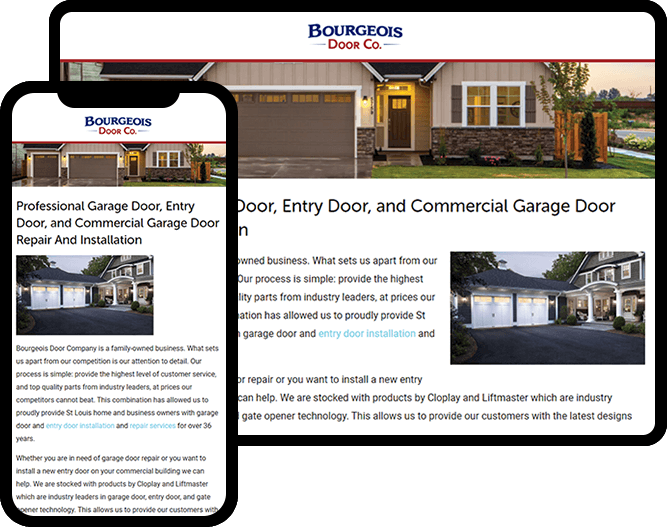88% of consumers are less likely to return to a website after a bad user experience.”
For home service companies, this means every second counts when a potential client visits your website. After ten years of working in home services marketing, I’ve learned that an effective website is more than just attractive—it’s a lead-generating machine.
What Makes a Home Service Website Different?
A home service business website has a distinct purpose—generating leads. This requires a design and marketing strategy that helps users navigate easily and find ways to contact you quickly.
CTAs should be prominently displayed. On mobile devices, which account for over 50% of web traffic, your CTAs should be easily tappable with a thumb and visible without scrolling. On the desktop, place them above the fold, where they catch the visitor’s eye immediately.
Also, you should streamline your contact forms and ask for only essential information. Name, email, phone, and service requested should suffice. If too many fields exist, your potential customers will leave before hitting submit.
Identify Why Your Website Isn't Converting:
If your website ranks well but does not generate conversions, you likely face issues that need to be addressed. Check out the list below to identify which aspects need optimization.
- Bounce Rate: If you rank well and get traffic but have a high bounce rate, poor navigation or mismatched content is likely the cause.
- Form Issues: When was the last time you tested the form on your website? A lack of conversions could be as simple as a broken or too-long contact form.
- CTA Placement: You should consider CTA placement individually for your website’s desktop and mobile versions.
- CTA Color: Look at your contact buttons to determine whether they stand out.
User Experience & Navigation—Keep It Simple
Simplicity is key to a home service website. Your visitors want to find the information they need quickly. A well-structured navigation menu should have just a few essential tabs: Home, About, Services, Contact. Each service page should be clear and concise, with easy access to schedule an appointment or request a quote. Avoid overwhelming users with too many pages.
For example, if your website serves as a platform for roofing, HVAC, or plumbing services, create separate service pages for each category, but ensure they’re easy to find from your homepage. Also, integrate SEO practices within your site architecture to ensure you’re ranking for the services you offer, like “Roof Repair in Austin” or “HVAC Installation in Chicago”.
Design for Mobile—It’s Non-Negotiable
With more than half of your traffic coming from mobile users, responsive design isn’t just a best practice—it’s a necessity. Text, images, and forms should adjust smoothly to different screen sizes. This improves user friendly experience and impacts your search engine ranking, as Google prioritizes mobile-friendly sites.
Real Example: In one instance, I helped a roofing company revamp their website by focusing on mobile optimization, improving load speed, and restructuring their navigation. I streamlined their mobile menu, making it easier to use, and introduced a secondary service navigation higher on the page to enhance accessibility. Additionally, I reduced the site’s load time by several seconds. The result? A 20% increase in conversions within three months, thanks to these improvements in usability and performance.
Boost Conversions with Strong CTAs
Your CTAs (Calls to Action) are the driving force behind your website’s lead generation efforts. Color choice plays a more critical role than you might think. For instance, colors like red create a sense of urgency, while people often associate green with safety and trust. Choosing the right color for your buttons based on the psychology of color can significantly impact your conversion rate.
Real Example: In one case, I conducted an A/B test for an HVAC company’s website. We tested red buttons against their existing blue ones. The red buttons showed a 10% increase in conversion rates. The lesson here is simple—don’t just stick with what looks nice, test what works for your audience. In addition to this, we always use text that drives actions like “Get a free quote” vs. “Book an appointment today.”
Placement is just as important as color. CTAs should appear in multiple strategic locations across your site. Place them at the end of every service page, in the header, and use a sticky button for mobile users. Give users different ways to reach you. You can use contact forms, click-to-call buttons, and live chats. Having variety and clear placements helps them take the next step.
Speed Matters—Optimize for Performance
A fast website is essential. Research shows that every second of delay in load time can reduce conversions by 7%.
So, how do you ensure your site is lightning-fast? First, compress your images without sacrificing quality. Use tools like TinyPNG or plugins to reduce file sizes.
Second, reduce code by cleaning up your JavaScript and CSS. This improves performance and helps with SEO. Tools like UglifyJS and plugins like WPRocket can help with this.
Also, think about using a Content Delivery Network (CDN) like Cloudflare. This will help your website load quickly for users in different places. A CDN keeps copies of your site on servers worldwide. When someone visits your site, it loads from the closest server. This helps reduce load times a lot.
Local SEO and Trust Signals—Essential for Success
To boost your online presence in in local search results, focus on Local SEO. Start by optimizing your Google My Business (GMB) listing. Make sure all your information is correct. This includes your business name, address, phone number, and hours of operation. Also, upload clear images of your work. Collect positive customer reviews on GMB and other platforms to boost credibility and improve local rankings.
Next, use localized keywords throughout your site content and metadata. Instead of just targeting “HVAC services,” aim for terms like “HVAC repair in Austin” or “roof installation in Denver.” This improves your chances of appearing in local searches.
Implement schema markup (structured data) to provide Google with clear details about your business, such as service type and locations served. This increases your visibility in local search results.
Additional Refinements:
- Bounce Rate: If users leave quickly after landing on your page, check for content mismatches or poor navigation. Your site needs to deliver the right information based on user intent. Users will bounce if you rank for “plumbing services near me,” but your content doesn’t immediately reflect that service.
- SEO Best Practices: Incorporate on-page SEO elements like meta titles, meta descriptions, and header tags. Each page should have a clear title that includes important keywords. For example, use “Professional Plumbing Services in Chicago.” This title should match what users are looking for. Additionally, optimize image alt text and internal linking to boost your search ranking and user experience.
Key Takeaways: Boost Your Home Services Website with Strong Navigation and CTAs
To grow your business, your website should be more than just a digital brochure—it’s a crucial part of your lead generation strategy. Make your home services website easy to navigate. Ensure it loads quickly. Use clear and effective calls to action (CTAs). This will help turn visitors into leads. In my experience, it’s these core elements that transform a basic site into a powerful tool that drives business growth.

